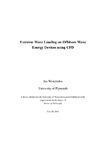Extreme Wave Loading on Offshore Wave Energy Devices using CFD
| dc.contributor.author | Westphalen, Jan | |
| dc.contributor.other | Faculty of Science and Engineering | en_US |
| dc.date.accessioned | 2014-02-03T15:23:36Z | |
| dc.date.available | 2014-02-03T15:23:36Z | |
| dc.date.issued | 2011 | |
| dc.date.issued | 2011 | |
| dc.identifier | Not available | en_US |
| dc.identifier.uri | http://hdl.handle.net/10026.1/2878 | |
| dc.description.abstract |
Two commercial Navier-Stokes solvers are applied to wave-wave and wave-structure interaction problems leading to the final application of simulating a single float of the wave energy converter (WEC) Manchester Bobber in extreme waves and a fixed section of the Pelamis in regular waves. First the two software packages CFX and STAR CCM+ are validated against measured results from physical tank tests concerning the interaction of 3 non-linear focused wave groups of different steepness (Ning et al. 2007). The agreement for all of these cases is very good and could even be improved from first order to second order wave setup at the wavemaker. However, in preliminary regular wave tests, the damping of the waves is identified to be an issue, which is the reason for focusing the waves and placing the structures in the following experiments approximately one wavelength behind the wavemaker. The interaction of fixed vertical and horizontal cylinders in regular waves are simulated concerning the forces on the structures (Kriebel 1998, Dixon et al. 1979). For the horizontal cylinder non-linear force oscillations of double the wave frequency could be modelled in good agreement with physical tank data, where linearised models failed. For the vertical cylinder the problem of the secondary load cycle due to a backward-breaking wave behind the cylinder is of special interest (Stansberg 1997, Chaplin et al. 1997). Here, the horizontal forces on a slender cylinder with a diameter approximately equal to the wave height are simulated successfully. Furthermore, the highly non-linear wave run-up in front of the cylinder is resolved well in the numerical approach. The next set of simulations includes rigid body motion. Here, the forced oscillations of a cone shaped body near the still water surface is simulated. These results are compared with test data published by Drake et al. (2008). For these cases the non-linearity of the experiments is discussed by comparing the sum and differences of the force and surface elevation time histories for a set of simulations with opposite excursion of the cone. The hydrodynamic forces on the cone surface are resolved in very good agreement. The solution of the surface elevation close to the cone surface is also resolved reasonably well. After having validated the codes for fixed wave-structure interaction problems and forced motion, the CFD methods are finally applied to problems relevant to the survivability of WECs. First a single float in waves is modelled. This challenging case combines the extreme wave setup with a floating body problem in one and two degrees of freedom including the interaction of the float inertia with the inertia of a separate mass attached to it. The vertical translations of the float are compared with physical tank tests by Stallard et al. (2008). This case clearly demonstrates the capabilities and challenges in using CFD to simulate WECs. When representing the pulley and counterweight system by a simplified external body force rather than the full setup, the calculated translations of the float agreed better with the measured results from the physical tank test. Furthermore the codes are used to simulate a single fixed section of the Pelamis device in regular waves. The surface elevations close to the device are discussed and the forces acting on different strips on the structure are presented. | en_US |
| dc.language.iso | en | en_US |
| dc.publisher | University of Plymouth | en_US |
| dc.title | Extreme Wave Loading on Offshore Wave Energy Devices using CFD | en_US |
| dc.type | Thesis | |
| plymouth.version | Full version | en_US |
| dc.identifier.doi | http://dx.doi.org/10.24382/4898 |
Files in this item
This item appears in the following Collection(s)
-
01 Research Theses Main Collection
Research Theses Main


